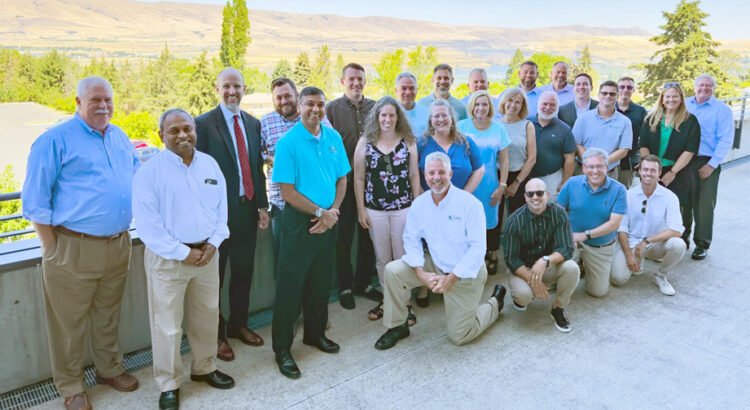Photo above – courtesy of Kenji Sugahara.
Twenty-seven states and the National Association of State Aviation Officials (NASAO) held the third meeting of the Advanced Air Mobility (AAM) Multi-state Collaborative in The Dalles, Oregon. Hosted by the Oregon Department of Aviation and Washington State Department of Transportation’s Aviation Division, the Collaborative’s meeting featured growing participation from additional states and the private sector. The AAM Multi-state Collaborative is working toward consensus on key AAM policy issues and how state government can support the roll-out of AAM services as a complement to Federal Aviation Administration efforts and a foundation for industry development.
The AAM Multi-state Collaborative, consisting of state government agencies focused on aviation or economic development from 27 states across the country with support from NASAO, serves as a forum for states to discuss the role of the states, state-level policies, and infrastructure needed to support AAM operations. The Collaborative is working toward finalizing a series of consensus topic papers that will help harmonize state efforts, while acknowledging states’ unique needs, so that the industry can expect consistency across the states and ensure that policies and infrastructure complement federal policy.
This meeting focused on continuing to exchange lessons learned among the states and working the first key consensus topic papers focused on clarifying the role and scope of the states, the harmonization of policy across the states, a shared approach to physical and digital infrastructure, and how we leverage our existing general aviation assets. It also provided states with the opportunity to engage with and seek input from industry leaders in drone delivery and air mobility, who provided invaluable input to assure that the state consensus includes concepts that support the viable development of the industry. The attending members agreed to present the final draft consensus topic papers at the NASAO Annual Convention & Trade Show in Pittsburgh, PA, from September 7 – 11, 2024, to receive final input before publishing the initial topics in the fall.
“In partnership with the FAA, states will play a critical role in successfully integrating AAM operations into the nation’s aviation system,” said Greg Pecoraro, NASAO President and CEO. “The AAM Multi-state Collaborative is important to that effort, and the work being done by these states and their partners is impressive in its depth and foresight.”
Greg Campbell, director of the Virginia Department of Aviation, said, “The AAM Multi-state Collaborative has made significant progress since its inception last year. As we work towards our goal of harmonizing state efforts and developing working plans to engage with the FAA and industry, we’ve identified seven key areas on which to focus. These include the role of the states, lessons learned, basic principles to approach AAM, policy harmonization, physical and digital infrastructure, extending and leveraging current infrastructure, and approaches to sustainable funding. We are now at a point where we are beginning to find consensus on these issues, which is critical to developing seamless AAM operations across the country.”
Kenji Sugahara, director of the Oregon Department of Aviation, said, “From eight states at the end of November 2023, to 18 states in February, to 27 states in July, the AAM Multi-state Collaborative shows the importance of and excitement surrounding state-level cooperation on advanced air mobility. Participants in this year’s FAA Drone/AAM Symposium also recognized the important role that states will play in the development of this future technology. We are proud to be part of this effort to move this new form of aviation forward.”
Ann Richart, Washington State Department of Transportation Aviation director, said, “AAM has the potential to not only transform the way we fly but provide additional transportation solutions to some of our most remote and underserved communities, as well as across the region. We were excited to co-host the Collaborative’s third meeting because the conversations happening today amongst the states, airports, OEMs and others will have profound impacts on how quickly we will be able to adopt these new technologies across the country and take advantage of the economic benefits.”
Founding members of the AAM Multi-state Collaborative include NASAO, Alaska, Ohio, Oklahoma, Oregon, Pennsylvania, Texas, Utah, and Virginia; with Alabama, California, Florida, Georgia, Idaho, Illinois, Kansas, Louisiana, Maine, Maryland, Massachusetts, Michigan, Minnesota, Montana, New Hampshire, North Carolina, Tennessee, Washington, and West Virginia joining earlier this year. Previous meetings were hosted by the Virginia Department of Aviation, JobsOhio (Ohio’s Economic Development Corporation), and NASAO.




